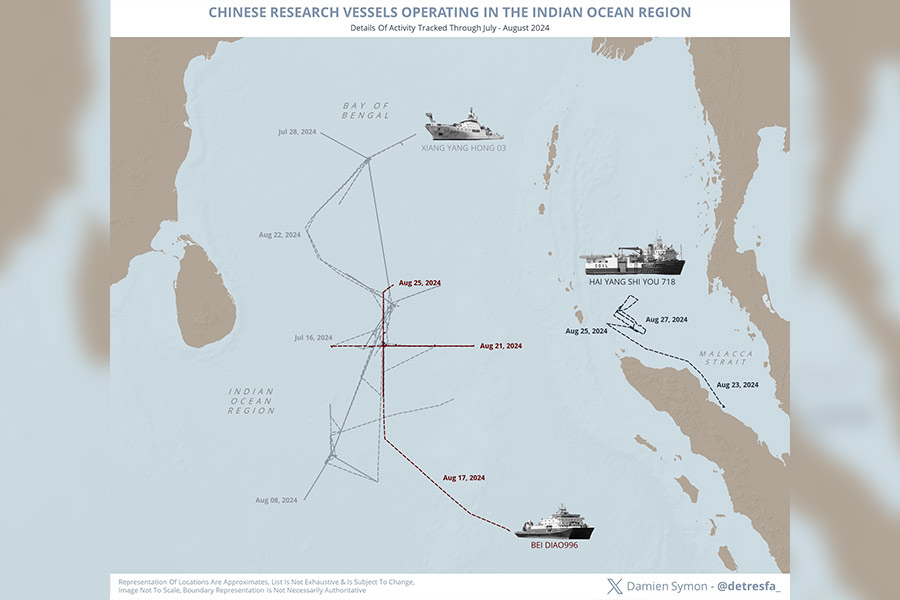The Chinese Navy is intensifying its presence in the waters surrounding India. Chinese research vessels have been active in the Bay of Bengal and the Indian Ocean and a mini-fleet of three warships have docked in Colombo on an official visit.
Throughout August, three Chinese survey ships have been prowling in the seas around the subcontinent with a notable pattern of increased activity when India is conducting military or space-related tests.
The heightened Chinese presence in Indian waters come as China and the Philippines exchanged charges at the weekend of deliberately ramming each other’s coast guard vessels near the Sabina Shoal. The disputed atoll is the newest flashpoint in a row between Beijing and Manila over territory in the South China Sea.
The Chinese survey ship Xiang Yong Hong 03 spent several weeks in the Bay of Bengal and Indian Ocean through July and early August. At one point, it was located 380 nautical miles from Chennai and 120 nautical miles from the area where India had announced it would be holding a sub-surface firing between July 27 and August 10.
Two other Chinese survey ships were also sailing in the Indian Ocean region during the same period. One was the Yuan Wang 7, a ship used for satellite and missile tracking. The other was the Zhong Shan Da Yue, commissioned in 2020 and described as China’s largest-ever oceanographic research and training vessel. The Zhong Shan Da Yue features a landing platform for drones and helicopters and has been referred to as “a large mobile laboratory at sea”.
Earlier in June, the Yuan Wang 07 also entered the Indian Ocean region just three days before India put out a warning about a 415 km No-fly zone from Balasore in Odisha where India has an integrated missile test range.,
In February and March, the Xiang Yang Hong 3 was the centre of a three-way diplomatic spat between India, the Maldives and China. The ship made a port call at Male 'for rotation of personnel and replenishment’. India had opposed the stopover and was hoping the Maldives government would deny the request.
Sri Lanka imposed a ban at the start of the year on Chinese research ships docking at its ports after strong lobbying by New Delhi and Washington which said the vessels might be spying. But under intense pressure from the Chinese, Sri Lanka is widely expected to lift the ban from next year. Cash-strapped Sri Lanka considers both India and China important partners in its task to restructure its external debt.
Globally, China’s naval activity is stirring concerns. Beijing has used the Chinese Navy as a key force to push aggressive claims against China’s neighbours. On Saturday, a Chinese coast guard ship collided with a Philippine coast ship at the Sabina Shoal.
China accused the Philippine ship of causing the collision. But a video of the incident clearly shows the Chinese ship was the aggressor. This was the latest of a series of midsea clashes between the two countries.
The US State Department condemned China for what it said was “deliberately” colliding with a Philippine coast guard vessel, calling the incident “the latest in a series of dangerous and escalatory actions” by Beijing.
Additionally on Saturday, a Chinese survey ship entered Japanese coastal waters, prompting a protest from Japan. It was the second incursion of its kind in less than a week.
In response to Chinese activities, the Indian Navy is closely monitoring all Chinese ships entering the Indian Ocean region. It tracks them and, in some cases, follows them at a discreet distance. When three Chinese warships – the He-Fei, Wuzhishan and Qillanshan – docked in Colombo last week, an Indian Navy vessel, the INS Mumbai, was berthed not far away in the port.
India has also stepped up its presence in the South China Sea. In May, the Indian Navy’s eastern fleet made a visit to the Philippines, Vietnam, Malaysia, Singapore and Brunei, reflecting India’s growing engagement in regional maritime activities.










